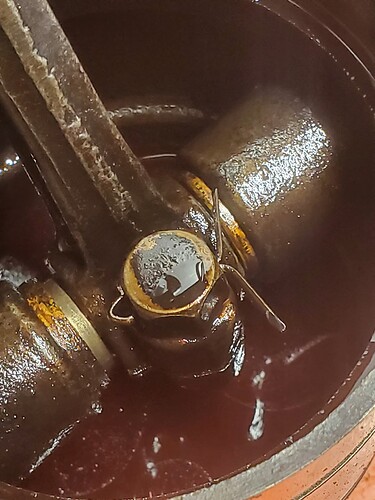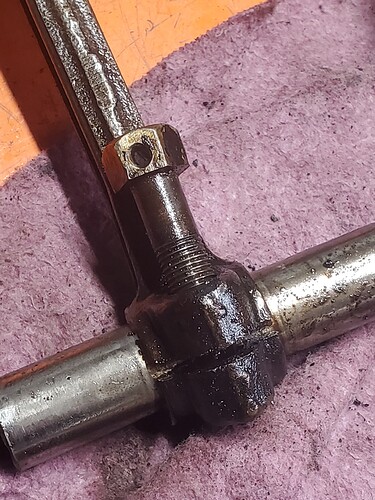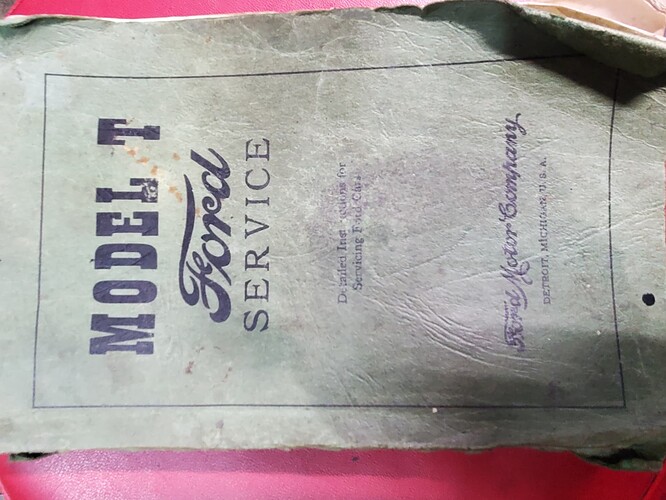Well folks, I’m going to quote 1924Fordor…" A tisket, a tasket, for an oil change should I use a gasket?"…Yes …would my reply. My “O” ring adaptation to my oil plug was a bust. Looked good but in application, but, it leaked. ![]() Not severe, none the less, it dripped.
Not severe, none the less, it dripped.
Hello again all. My winter to-do list just took a hit. For fun (or so I thought), I figured I’d do a compression test to compare what my Dad and I had 14 years ago…it was on the lower end…50 psi on all 4. Well, #3 came in at 30 psi. Leak down test and got a nice hiss out the exhaust manifold. Not surprised, but, dag nab it! So, now the head is off and diving in to what it’s going to take to make it right. Not what I really wanted to see, but glad I did the test. Deal with it now to have years of problem free motoring!
Moved by me to here. Was in the wrong spot.
Well, got the hogs head that I fixed back on, but had a leak at the front passenger side corner, so it’s back off to fix. Before I pulled it off I did a compression test and # 3 was 20 psi lower than the rest(only 50 psi the rest). I did a leak down test and found the exhaust valve leaking. Uh oh…rabbit hole is opening up. Pulled the head and the valve had about 5% contact. Okay, need some valves. I"m standing there looking at it and thought, it’s open, might as well. Rabbit hole officially entered. Pistons are now out, cylinders are going to be de-glazed and new stock rings installed. Engine has had a very easy life…only .004 thou over 3.75 stock bore and concentric.
Hello all. After installing my repaired hogs head with new outside oil line, I had a leak at the passenger side front. So, it’s off again to correct the issue. One thing I noticed at disassembly that there wasn’t any oil in the outside line. Car was running for about a 1/2 an hour. I figured there should be some oil. What about a scoop on the inside at the hole? How tall can it be? If I’ve done my measurements correctly, I figure it can only be about 1/4 inch before I stand a chance of getting caught in the magnets. To me that is so short it really wouldn’t catch any oil either. Thank you in advance to all who offer insight.
I would look for a clog of some kind. I have left the outside oil line off at the front by accident after doing some maintenance and it leaked two quarts on a trip around the block.
That’s the thing. No blockage. All brand new. There wasn’t even oil in the fitting on the hogs head when i pulled the tube off. Now, all this being said, I have a dip stick for oil level and I got too much in it so i used the upper petcock to get to the correct level, and when I drained the oil for other reasons, I only got 3.5 quarts out. I would assume that the remaining 1/2 quart is still in there due to the 4 dip pan. Now if it isn’t, being down 1/2 quart shouldn’t make that much a difference. On the store bought outside oil line kits, how big is the hole in the hogs head?
Hello all. Another question. I have taken a con rod off a piston to clean and I’m a bit befuddled. There was a cotter pin in the head of the bolt. For what reason? It doesn’t do anything that I can see. Don’t see how it would prevent it from backing off like a pin through a nut and bolt.
The kits I use take the place of the magneto post. I have not used the kind where you have to cut another hole.
You need to do it like the factory did. The nut is cotter pinned to the rod bolt.
That’s the thing. It’s a bolt, no nut. The bolt threads into the other half of the split that pinches the wrist pin.1st picture shows con rod attached to the piston and you can see the cotter pin, not connected to anything. All are like this. The 2nd picture is of the one I have apart. You can see the hole in the head of the bolt. This car has been in our possession since 1975 and was in pieces when purchased. We never opened the engine because it ran. So, is it supposed to be wired? That would mean someone’s been in to the engine before '75. Not sure why though because of the cylinders still being stock size.
Upon further investigation on this quandary, I went to the reprint of the servce book I have. Hope the picture isn’t sideways.
And found this picture.
My guess at this point would be that the tail of the pin is bent over the side of the wrist pin eye to prevent the bolt from coming completely out in the event that it should become loose. Thoughts!?
Ahh OK it’s the wrist pin bolt. Yes that one is supposed to be cotter pinned or safety wired to prevent rotation.
Auto_Inn, absolutely makes sense in what your are saying. Figured that was the intention here. What threw me was the size of the cotter pin and positioning. It might have stopped the bolt from coming completely out had it come loose, but the cotter pins that are there are very light weight wire size, and were sloppy in the hole in the bolt head. I will be installing a thicker/ heavier gauge wire cotter pin before I re-install the piston.
I’ve always used .040" stainless safety wire on those. I go through the hole in the bolt then around the rod and twist.
That makes good sense. I’ll have to look and see if i can get some.
Hello all. Got me some tie wire for the wrist pin bolts. Progress on the car has stalled as I’m waiting on parts. Figured I’d have them by now. Would really like to start putting my car back together. But I understand that patience will pay off, and I’ll get the car back together before the nice weather and cruises start, but…I really want to hear it run with new valves and rings. ![]()
Hello all. It’s fun time in my shop. Picked up gaskets, exhaust manifold, rings, valves etc. today. Going to start the process of getting my car back together ![]() . Has anyone bothered to try and balance their pistons and con-rods? I see some good spots on the con-rods to remove material without compromising the rod, but where would you remove material on a cast iron piston to enable weight matching with the others? Is it even feasible?
. Has anyone bothered to try and balance their pistons and con-rods? I see some good spots on the con-rods to remove material without compromising the rod, but where would you remove material on a cast iron piston to enable weight matching with the others? Is it even feasible?
Yes, you can balance the components, see the link below, it is part of a complete series of engine and transmission rebuild videos.
If you want to further reduce the loads on the crankshaft, you might consider using aluminum pistons. They use a modern ring pack and are much lighter than the stock cast iron pistons.
Thanks cudaman. That’s good info to watch. I new where I could remove material from the con-rods, but was unsure about the pistons. Staying with the stock cast ones, just wanted to make it run a little smoother. Still have to get a scale to check weights.
Hello all. For those who have installed valves with over sized stems. What did you do to ensure that the drill bit, then reamer was straight? I’m considering renting a mag drill to do this, but was wondering if there is a more cost effective way without sacrificing accuracy.



